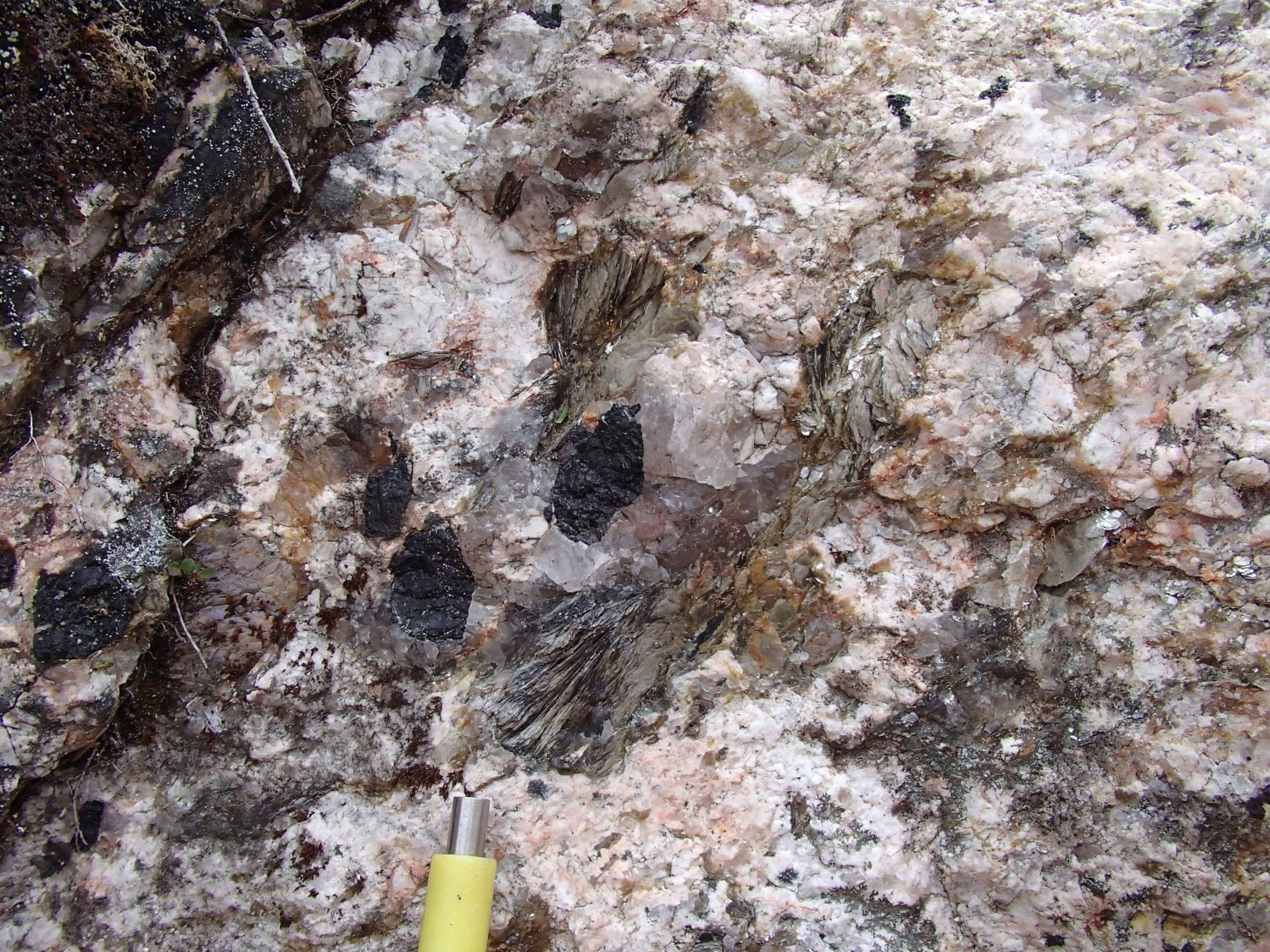
First published: 20 October 2016
Last modified: 10 December 2020
DISCLAIMER: This English version is translated from the original French. In case of any discrepancy, the French version shall prevail.
| Author(s): | Simard et al., 2013 |
| Age: | Paleoproterozoic |
| Stratotype: | None |
| Type area: | Kuujjuaq area (NTS sheet 24K) |
| Geological province: | Churchill Province |
| Geological subdivision: | Rachel-Laporte Lithotectonic Domain |
| Lithology: | Massive felsic intrusive rocks |
| Category: | Lithodemic |
| Rank: | Suite |
| Status: | Formal |
| Use: | Active |
None
Background
The Mercier Suite was defined in the Kuujjuak and Ungava Bay areas (Simard et al., 2013) to group all granitic intrusions of the Rachel-Laporte Lithotectonic Domain. Most of these intrusions were described by Gélinas (1958, 1965) and were not revisited during the Ministère’s 1:250 000 mapping work between 2011 and 2016. The Mercier Suite was continued southward in the Saffray Lake (Lafrance et al., 2014), Jeannin Lake (Charette et al., 2016) and Résolution Lake areas.
Description
The Mercier Suite consists of two units: pegmatitic granite, tonalite and granodiorite (pPmrc1), and massive pink granite (pPmrc2).
Mercier Suite 1 (pPmrc1): Pegmatitic Granite, Tonalite and Granodiorite
Massive felsic intrusive rocks of unit pPmrc1 occurs as decimetric to decametric intrusions oriented parallel to foliation in metasedimentary rocks and amphibolites of the Laporte Supersuite (Freneuse and Klein suites). The geochemistry of this unit suggests that it comprises various intrusions (Lafrance and Vanier, 2021). These intrusions are depleted in ferromagnesian minerals and commonly display a well-developed graphic texture at the megascopic scale. Its colour can vary rapidly from white to pink on the same outcrop. They are composed of plagioclase, quartz (25-35%), muscovite clusters (10-20%), varying amounts of K-feldspar (3-20%), and small chloritized biotite flakes (1-3%). They also contain 1-15% millimetric to centimetric crystals of accessory minerals such as tourmaline, garnet, apatite and hematite.
In the Kuujjuaq area, Gélinas (1965) states that the amount of pegmatitic granite dykes and sills increases from west to east.
Mercier Suite 2 (pPmrc2): Massive Pink Granite
The Mercier Suite also includes a major intrusion (25 km x 5 km) of biotite pink granite in the Saffray Lake area (Lafrance et al., 2014). Granite is pink, very homogeneous, massive, medium to coarse grained and contains <5% biotite. It contains in places some decimetric amphibolite enclaves. Granite of unit pPmrc2 resembles that of the Dancelou Suite in the Baleine Lithotectonic Domain.
Thickness and distribution
The Mercier Suite covers an area of ~235 km2. Unit pPmrc1 forms small intrusions <1 km wide in the Rachel-Laporte Lithotectonic Domain, with a greater concentration in the northern part of the area. Unit pPmrc2 consists of a large-scale granitic intrusion (25 km x 5 km) that cuts Archean rocks of the Rénia and Highfall complexes, on the edge of the Lac Turcotte Fault, in the Saffray Lake area (Lafrance et al., 2014).
Dating
None.
Stratigraphic Relationship(s)
The lack of deformation suggests that the Mercier Suite emplaced after the New Quebec Orogen, which occurred between 1.82 Ga and 1.77 Ga (Machado et al., 1989). Intrusive rocks of unit pPmrc1 cut metamorphosed volcano-sedimentary rocks of the Rachel-Laporte Lithotectonic Domain, namely the Freneuse and Klein suites. Granite of unit pPmrc2 cuts Archean rocks of the Rénia and Highfall complexes. Its late-tectonic emplacement and location at the edge of the Baleine Lithotectonic Domain does not rule out the possibility that this unit is related to the Dancelou Suite, which comprises a similar pink granite unit within the Baleine Domain (Lafrance and Vanier, 2021).
Paleontology
Does not apply.
Publications available through SIGÉOM Examine
CHARETTE, B., LAFRANCE, I., MATHIEU, G., 2016. Géologie de la région du lac Jeannin, Québec, Canada. MERN; BG 2015-01, 1 plan.
GELINAS, L., 1958. RAPPORT PRELIMINAIRE SUR LA REGION DU LAC GABRIEL (PARTIE OUEST), NOUVEAU-QUEBEC. MRN; RP 373, 13 pages, 1 plan.
LAFRANCE, I., SIMARD, M., BANDYAYERA, D., 2014. GEOLOGIE DE LA REGION DU LAC SAFFRAY (SNRC 24F, 24G). MRN; RG 2014-02, 51 pages, 1 plan.
LAFRANCE, I., VANIER, M.-A. 2021. Domaine lithotectonique de Rachel-Laporte, sud-est de la Province de Churchill, Québec, Canada : synthèse de la géologie. MERN; BG 2021-01
SIMARD, M., LAFRANCE, I., HAMMOUCHE, H., LEGOUIX, C., 2013. GEOLOGIE DE LA REGION DE KUUJJUAQ ET DE LA BAIE D’UNGAVA (SNRC 24J, 24K). MRN; RG 2013-04, 62 pages, 1 plan.
Other publications
GÉLINAS, L. 1965. Géologie de la région de Fort Chimo et des lacs Gabriel et Thévenet, Nouveau-Québec. Thèse de doctorat, Université Laval, Québec; 212 pages.
MACHADO, N., GOULET, N., GARIÉPY, C. 1989. U-Pb geochronology of reactivated Archean basement and of Hudsonian metamorphism in the northern Labrador Trough. Canadian Journal of Earth Sciences; volume 26, pages 1-15. https://doi.org/10.1139/e89-001
Suggested Citation
Ministère de l’Énergie et des Ressources naturelles (MERN). Mercier Suite. Quebec Stratigraphic Lexicon. https://gq.mines.gouv.qc.ca/lexique-stratigraphique/province-de-churchill/suite-de-mercier_en [accessed on Day Month Year].
Contributors
|
First publication |
Isabelle Lafrance, P. Geo., M.Sc. isabelle.lafrance@mern.gouv.qc.ca (redaction) Mona Baker, P. Geo., M.Sc. (coordination); Thomas Clark, P. Geo., Ph.D. and James Moorhead, P. Geo., M.Sc. (critical review); Claude Dion, P. Geo., M.Sc. (editing); Céline Dupuis, P. Geo., Ph.D. (English version); Caroline Thorn (HTML editing). |



